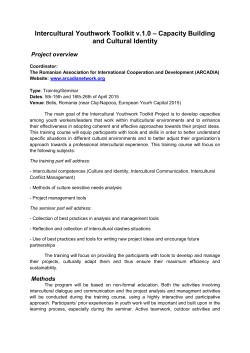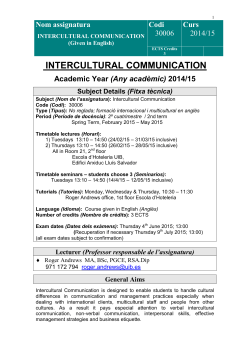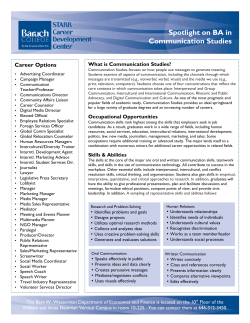
Intercultural Learners, Intercultural Brokers and ESP
Available online at www.sciencedirect.com ScienceDirect Procedia - Social and Behavioral Sciences 173 (2015) 106 – 112 32nd International Conference of the Spanish Association of Applied Linguistics (AESLA): Language Industries and Social Change Intercultural learners, intercultural brokers and ESP classrooms: The case of a shipping business course Ana Bocanegra-Vallea* a University of Cádiz, Area de inglés, Campus Universitario, Puerto Real (Cádiz) 11510, Spain Abstract This paper explores the ways in which “interculturality” can be embedded in the English for Specific Purposes (ESP) classroom and presents a project developed within a “Shipping Business English” course whose ultimate aim is to provide students with opportunities for gaining awareness across cultures at the same time English is used as the means of communication and language is integrated with content. Conclusions point at the new role of ESP teachers as “intercultural brokers” and prove that ESP classrooms provide a suitable context to explore foreign cultures by bringing them in line with each student’s home culture and the specific contents of the ESP course. © 2015 2015The TheAuthors. Authors. Published by Elsevier © Published by Elsevier Ltd. Ltd. This is an open access article under the CC BY-NC-ND license (http://creativecommons.org/licenses/by-nc-nd/4.0/). Peer-review under responsibility of Universidad Pablo de Olavide. Peer-review under responsibility of Universidad Pablo de Olavide. Keywords: interculturality; maritime English; intercultural broker 1. Introduction This paper concurs with Pulverness’ (2003, p. 426) strong assumption that “language teaching and learning invariably involve issues of sociocultural meaning, and that approaches which disregard the cultural dimension of language are fundamentally flawed”. The European Higher Education Area (EHEA) has set the framework for the introduction and promotion of multicultural awareness in current European educational systems through various instruments. The European Language Portfolio (ELP) and the Common European Framework of Reference for * Corresponding author. Tel.: +34 956 016122 E-mail address: ana.bocanegra@uca.es 1877-0428 © 2015 The Authors. Published by Elsevier Ltd. This is an open access article under the CC BY-NC-ND license (http://creativecommons.org/licenses/by-nc-nd/4.0/). Peer-review under responsibility of Universidad Pablo de Olavide. doi:10.1016/j.sbspro.2015.02.038 Ana Bocanegra-Valle / Procedia - Social and Behavioral Sciences 173 (2015) 106 – 112 107 Languages (CEFR) (Council of Europe, 2001) reflect the Council of Europe’s concern with the protection of cultural and linguistic diversity, the promotion of intercultural learning and the development of intercultural awareness in view of intercultural competent citizens. The footprint of interculturality leaves its mark throughout the ELP and the CEFR, and even though there is no particular section for culture, several cultural references spread through its examples (Tomalin, 2008). Additionally, in the field of English for Specific Purposes (ESP), “culture” is emerging and has been identified as a key area of enquiry together with “teaching” and “discourse” (Basturkmen, 2013). The CEFR incorporates the “intercultural dimension” into the language learning/teaching process and emphasises the relevance of “intercultural awareness” and “intercultural competence”, the latter developed as a set of skills known as “intercultural skills”. This paper is concerned with the first intercultural skill stated by the Council of Europe (2001, p. 104): “the ability to bring the culture of origin and the foreign culture into relation with each other”. It explores the ways in which interculturality can be embedded in the ESP classroom and presents a project developed within the “Shipping Business English” course whose ultimate aim is to provide students with opportunities for gaining awareness across cultures at the same time English is used as the means of communication and language is integrated with content. Even though this paper focuses on a particular ESP case, it might raise the interest of all those teachers, course designers and materials developers that need to implement the intercultural component in their ESP courses. 2. Background Maritime English has to satisfy the communicative needs and face the challenges of today’s global shipping industry in which 80% of the world’s merchant fleet is multilingual, multicultural, multinational, multiethnic or mixed, and English is the common working language. This gives rise to both language and culture-based miscommunicative events affecting a ship’s safety and management, as well as the working conditions, mental health and welfare of those aboard and ashore. Ships may be regarded as “micro societies” on board which professionals not only work but live together twenty-four hours a day. Reports from many international organisations that investigate marine safety contain plenty of examples of shipping accidents in which language misunderstandings and/or cultural differences have put the vessel, the people on board and the environment at stake (Bocanegra-Valle, 2010, 2013). There have been some attempts worldwide to cover the intercultural component as a teaching element in Maritime English courses – among others, the MARCOM project (European Commission, 1999) or the Model Course on Maritime English (International Maritime Organisation, 2000). 3. Description of the project 3.1. Participants The students taking part in this project were 30 home students, who acted as audience and assessors, and 10 international exchange students (IESs), who acted as speakers and presenters. Fifteen home students and five IESs per year attended the course “Shipping Business English” in the second semesters of 2011 and 2012. IESs attending the degree of Navigation and Seaborne Transport at the Spanish University of Cadiz mostly come from the EUfunded Socrates/Erasmus Exchange Programme – although there are other mobility programmes in effect like the “Aula Universitaria Hispano-Rusa” (Hispanic-Russian University Foundation). 3.2. Aims and expected result The general aim of this activity was to take advantage of mobility students and bring foreign and home cultures together into this particular ESP classroom. As “multicultural knowledge” is not contained in the students’ major in a formal way (this is, as a separate course or as a part of the syllabus of a particular course) this activity (project) was set up so that home students would have the opportunity to learn about different cultures from their international fellow classmates, and international students could “show” their country and culture in view of integration – as one 108 Ana Bocanegra-Valle / Procedia - Social and Behavioral Sciences 173 (2015) 106 – 112 Polish student stated in a personal talk: “This will give me the opportunity to make myself known and be known much better”. The connection with the official syllabus was a revision session to Unit 1 (“Port facilities and services”) and Unit 2 (“Port management and organization”). Together with this, the particular aims were: to embed the “intercultural dimension” in the ESP teaching/learning process; First point to raise awareness of intercultural communication within the profession; to explore home and foreign cultures; to gain an understanding of the otherness; to reflect on one’s own culture for mutual understanding; to promote curiosity and openness about other cultures; to revise port services and management (units 1 & 2 of the course syllabus) as they exist around the world. The most immediate result would be to develop and deliver a 10-minute oral presentation on a particular maritime commercial port in their country (describing port location, port facilities, port terminals, handling equipment, port management organization, etc) preceded by an introduction to the students’ country and culture. x x x x x x x 3.3. Procedure The stages for the development of the full project (see Fig. 1) are as follows. Step 1: Briefing Step 7: Further practice Step 2: Draft submission and revision Step 3: Final text submission Step 4: Oral presentation Step 6: Individual work Step 5: Class group discussion Fig. 1. Project procedure. Step 1. Briefing: Practitioner and student meet in a preparatory meeting. In this meeting the instructions are discussed and agreed on (deadlines, presentation date, length, duration, visual aids, delivery format, etc.). Then, the information (cultural topics and target port) to be dealt with is also discussed and agreed (see Table 1 for a list of potential topics and hints for discussion). Step 2. Draft submission and revision: Students submit their presentation draft via email attachment. The draft is digitally revised in both content and form, by inserting amendments, making suggestions, correcting misprints, etc. (see Fig. 2). Next it is emailed back to the student for revision. If further queries or doubts regarding content or format arise at this stage, these are answered either personally after class time or via email. Step 3. Final text submission: Students submit the final text via email attachment. The practitioner revises such document once more and approves it or proposes further changes until a final document is passed. Step 4. Oral presentation: Students deliver their oral presentation, which is digitally recorded. Step 5. Class group discussion: Home students are encouraged to ask questions and raise topics for discussion. Step 6. Individual work: Home students answer an ad hoc exercise (Comprehension Test). They are also encouraged to express their opinion about the presentation in writing and asked to assess the IESs’ performance as oral speakers in terms of presentation content, visual aids, and performance (see http://www.empa.ch/plugin/template/empa/*/50158 for the sample evaluation form used). Ana Bocanegra-Valle / Procedia - Social and Behavioral Sciences 173 (2015) 106 – 112 Step 7. Further practice: The presentation file is uploaded at Campus Virtual (repository “Ports of the World”) so that current and future students can have access to the information and view the presentation as originally prepared by international fellow colleagues (see Fig. 3). The comprehension exercise together with the key is also made available for providing further autonomous work. Table 1. List of suggested topics and hits for discussion. Main topic Sub-topics Domestic life Domestic habits Food Celebrations Language University life and studies Institutional life Politics and government organization Data of interest (currency, population, etc.) Religion Sports, literature and music Media Icons and History Famous people Famous historical events Famous monuments and sights Famous cultural events Other highlights Myths about my country and its people Curiosities about my country and its people ……………………………… Fig. 2. Draft submission and revision (Step 2). 109 110 Ana Bocanegra-Valle / Procedia - Social and Behavioral Sciences 173 (2015) 106 – 112 Fig. 3. Repository at Campus Virtual for further work (Step 7). 4. Main outcomes and conclusion At the same time interculturality is embedded in the ESP syllabus and classroom, we are complying with the educational requirements laid down by the EHEA and with the demands of a global profession that uses English as the international language of communication. The oral presentations serve to provide authentic material as a baseline for oral discussion during class time and, once uploaded at Campus Virtual, they supplement course activities with additional materials for extra and autonomous work. Here, Shipping Business English learners are “intercultural learners” because, among others, they “use language to explore different cultures” (Corbett, 2010, p. 1). Moreover, “in some teaching situations the class will itself be multicultural, and therefore it will naturally provide an arena for intercultural exchange and discussion” (Corbett, 2010, p. 2). And this is the case of this ESP classroom that has proved to be a suitable context to explore international cultures by bringing them in line with each student’s home culture. Home learners are decentred in favour of visiting students and learners are encouraged to make introspective analyses of the foreign cultures as compared to theirs. Another important issue is that the Englishnative standard is challenged in view of an international English model in which English is used as the language for international and intercultural communication and not as the native language of Anglophone countries only. It should be noted that home students make a homogenous group of Spanish native speakers but the group of IESs is heterogeneous by nature as it may gather a number of nationalities; hence, they bring into the classroom a variety of foreign languages and cultural backgrounds. It is not the case that only Spanish students are learning about the Polish culture, to give an example, but Russian, Belgian, Latvian or Dutch students are also gaining awareness of the Polish culture (see Fig. 4). In short, intercultural classrooms provide opportunities for gaining cross-cultural awareness using English as the means of communication. This project has been developed in two different academic years, with different home and international student groups, and in both cases, the experience has proved to be very motivating and mutually enriching, for international and home students, and myself (the teacher in this case) as a guide, intermediary and facilitator in the whole process. Ana Bocanegra-Valle / Procedia - Social and Behavioral Sciences 173 (2015) 106 – 112 111 Spanish students Belgian students Latvian students Polish students Russian students Dutch students Fig. 4. Cross-cultural awareness-raising in a Spanish classroom of Shipping Business English upon an oral presentation by Polish students. On the one hand, IESs were very thankful for the opportunity given. They highlighted on different occasions throughout our talks that they were “proud” to show their country and make themselves and their culture visible in an Anglo-dominated world. Some of them, having some seafaring experience, argued that they had never come across English-speaking natives aboard ship, so activities or projects such as this helped to connect university life with the profession and strengthen the view of ships as multicultural societies. On the other hand, home students put forward very positive comments when they were invited to write under the section “Comments” in the Comprehension Test sheet. Adjectives such as “very motivating”, “very interesting”, “different”, “innovative”, “nice experience”, “very amusing” readily come up among the home students’ comments. Below is a sample quote: (…) I found it was a very pleasant way of bringing in the knowledge of a foreign language, supplemented with a general overview of another culture. This type of activities fosters more entertaining learning and encourages learners to improve their relationships with foreign mates. I would like to highlight the work carried out by both foreign students and our teacher regarding the presentation content and lay out. (Comment originally in Spanish from a home student after the oral presentation on the Ports of Poland) As far as I, as a practitioner/teacher/educator, am concerned, I share Michie’s (2003, p. 2) view that “educators (including teachers) are among the groups of cultural workers who may find themselves in cultural borderlands of one type or another” and find his notion of “cultural broker” a handy and timely way to define my role in this particular project. That is to say, it has been my intention to act as an intermediary between groups of students of differing cultural backgrounds for the purpose of encouraging cross-cultural knowledge and understanding in the short term, and reducing potential cultural misunderstandings in the long run in view of a healthy multicultural workplace. References Basturkmen, H. (2013). Between territories and domains: and ESP-oriented enquiry in the borders – course development, genre analysis, and the role of ESP in education. Asp, 64, 17–27. Bocanegra-Valle, A. (2010). Global markets, global challenges: the position of Maritime English in today’s shipping industry. In A. Linde López & R. Crespo Jiménez (Eds.), Professional English in the European context: the EHEA challenge (pp. 151–174). Berlin: Peter Lang. Bocanegra-Valle, A. (2013). Maritime English. In C. A. Chapelle (Ed.). The encyclopedia of applied linguistics (pp. 3570–3583). Oxford: WileyBlackwell. Corbett, J. (2010). Intercultural language activities. Cambridge: Cambridge University Press. Council of Europe (2001). Common European framework of reference for languages: learning, teaching, assessment. Strasbourg: Cambridge University Press. European Commission (1999). The MARCOM project final report. The impact of multicultural and multilingual crews on MARitime COMmunication. Retrieved from < http://www.transport-research.info/Upload/Documents/200310/marcom.pdf>. Accessed 10 Feb 2014. International Maritime Organisation (2000). Model course 3.17: maritime English. London: IMO. 112 Ana Bocanegra-Valle / Procedia - Social and Behavioral Sciences 173 (2015) 106 – 112 Michie, M. (2003). The role of culture brokers in intercultural science education: A research proposal. Paper presented at the 34th annual conference of the Australasian Science Education Research Association held in Melbourne, 10-12 July 2003. Retrieved from <http://members.ozemail.com.au/~mmichie/culture_brokers1.htm. Accessed 10 Feb 2014. Pulverness, A. (2003). Materials for cultural awareness. In B. Tomlison (Ed.), Developing materials for language teaching (pp. 426–438). London: Continuum. Tomalin, B. (2008). Making culture happen in the English language classroom. Teaching English. British Council. Retrieved from <http://www.teachingenglish.org.uk/think/articles/making-culture-happen-english-language-classroom>. Accessed 10 Feb 2014.
© Copyright 2025









